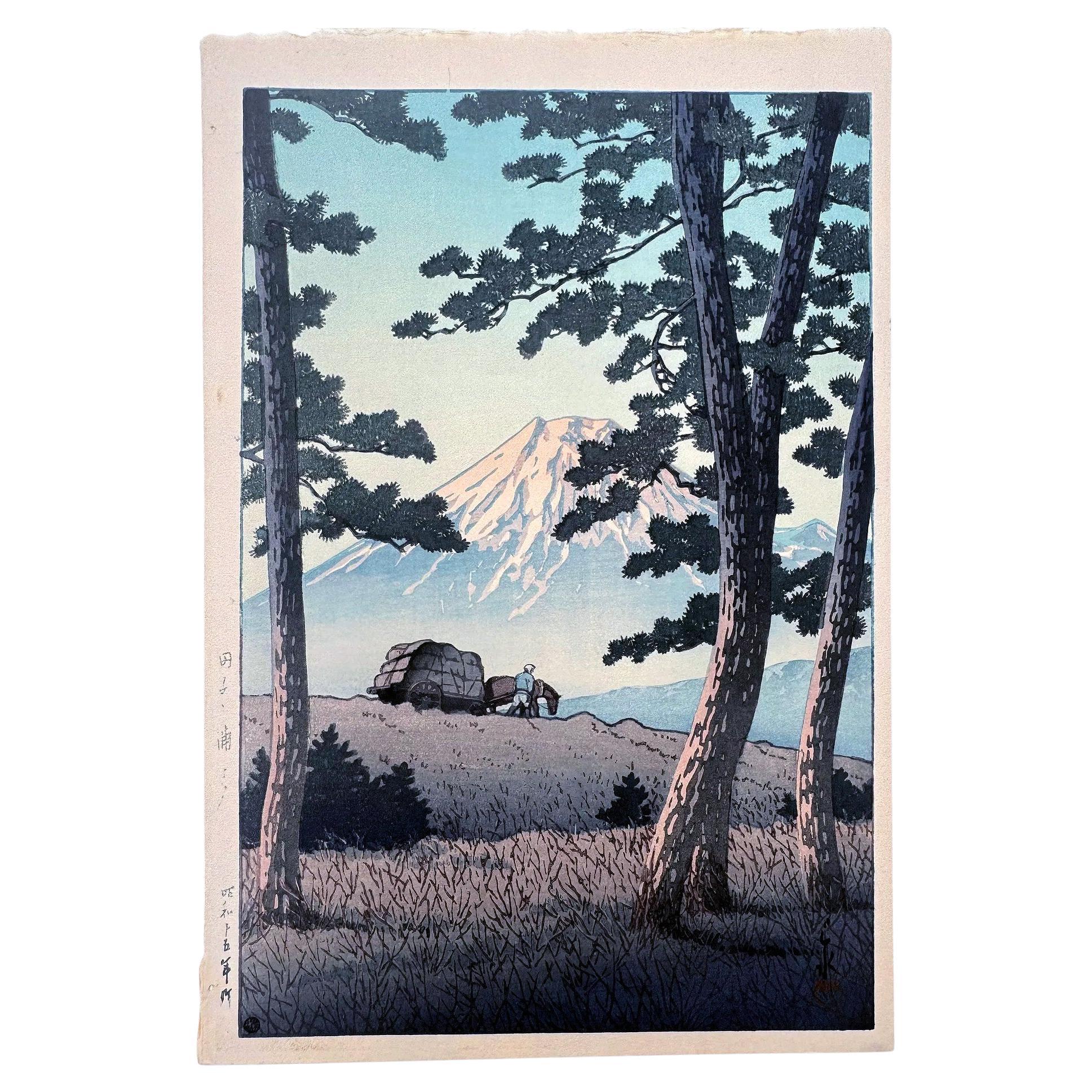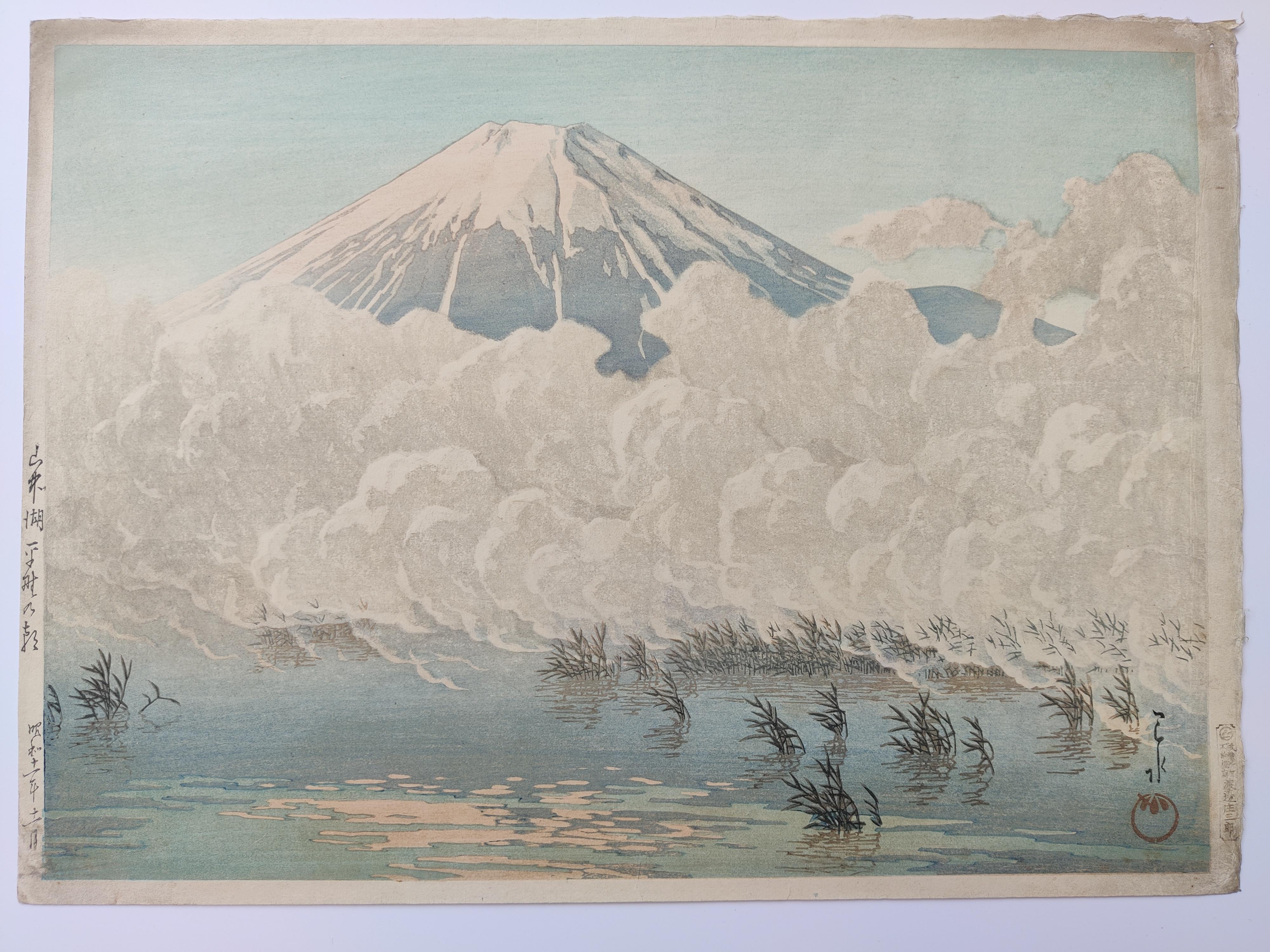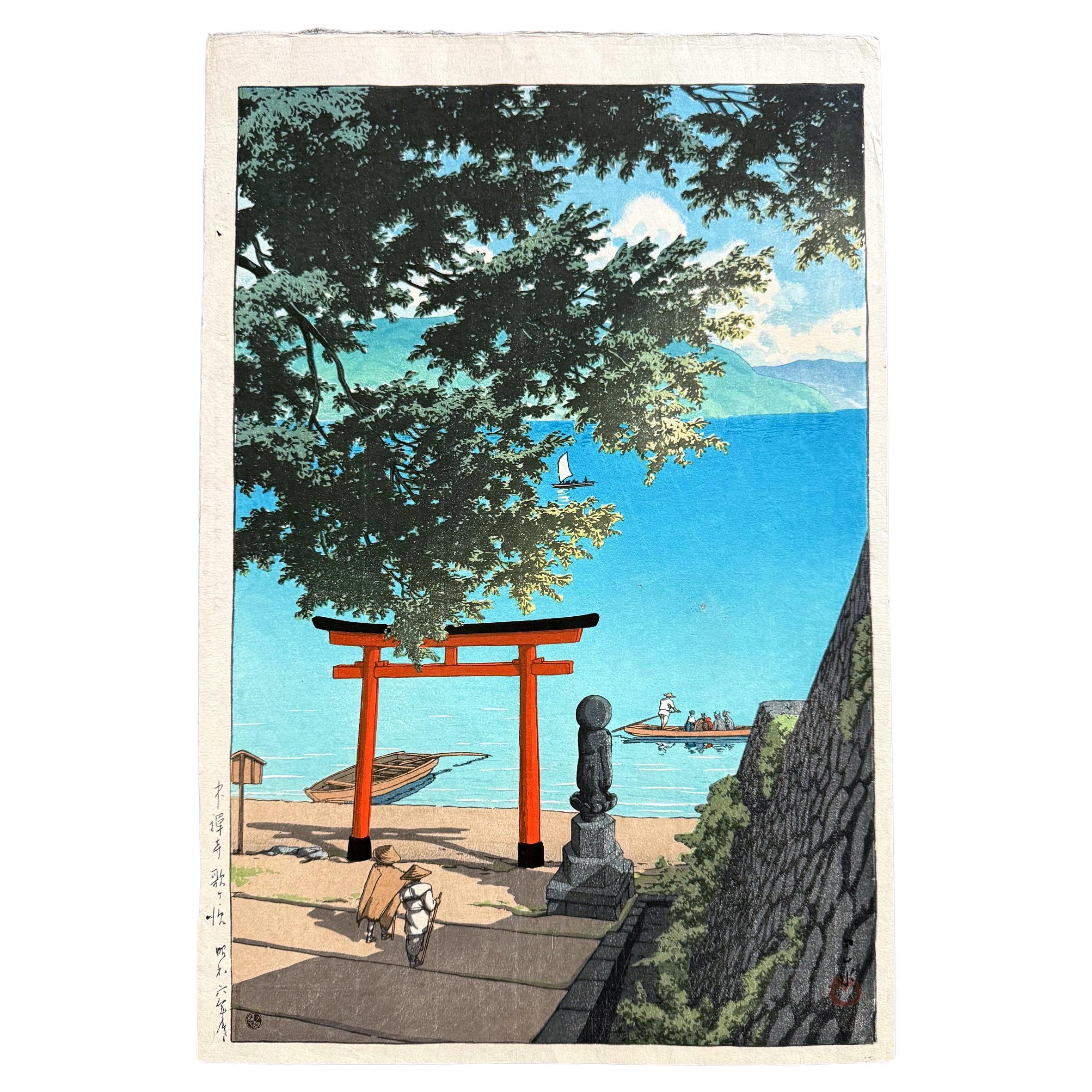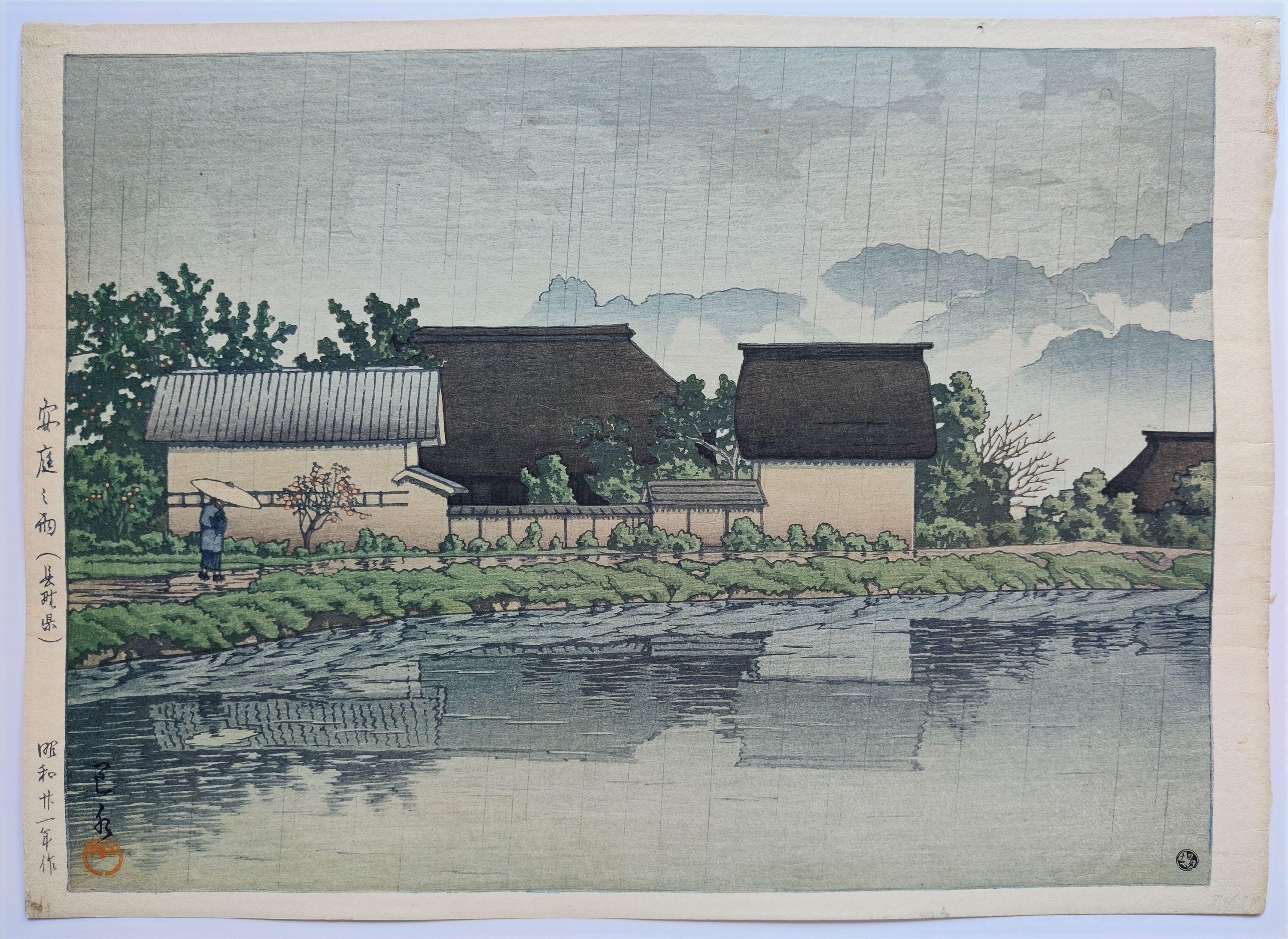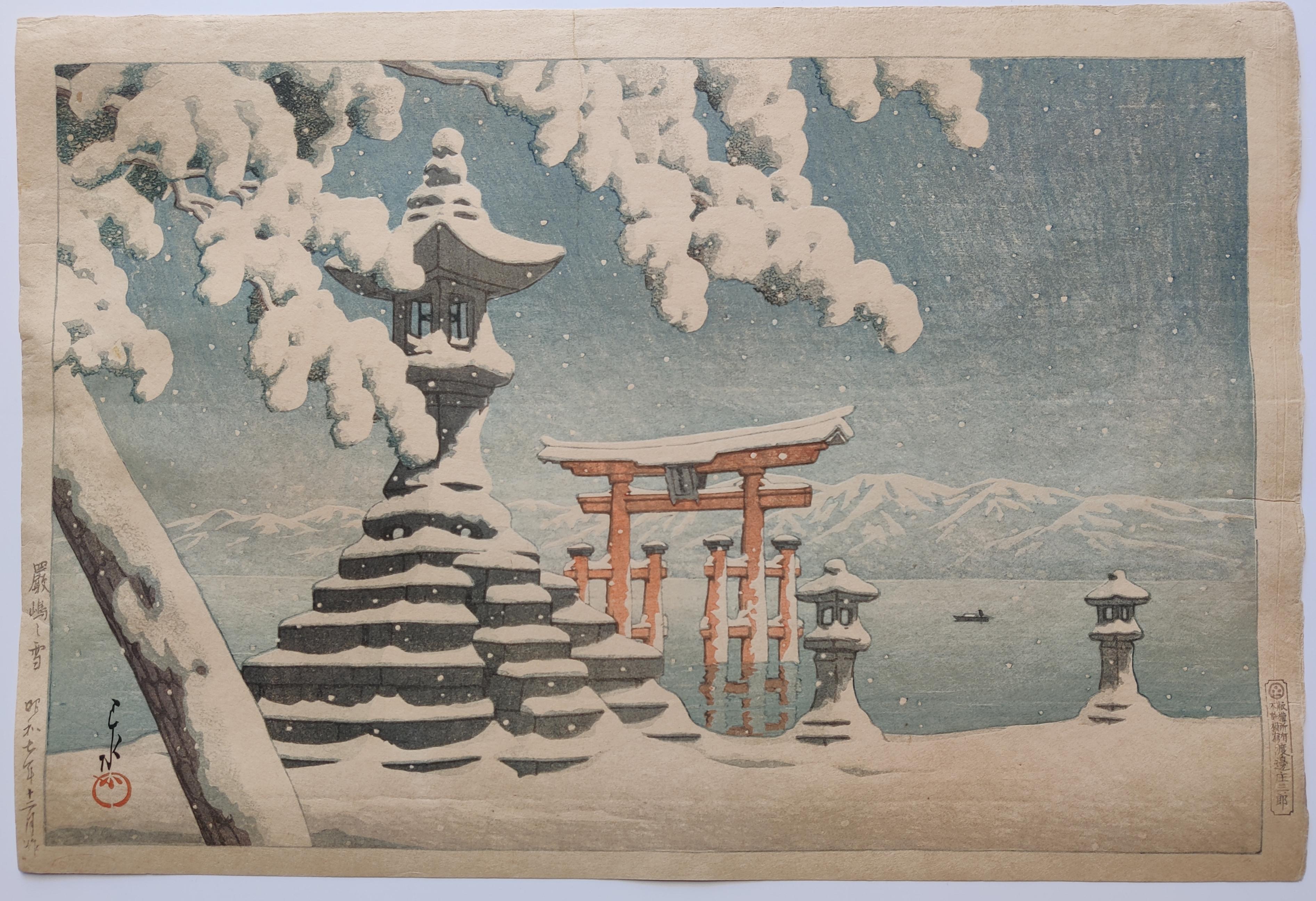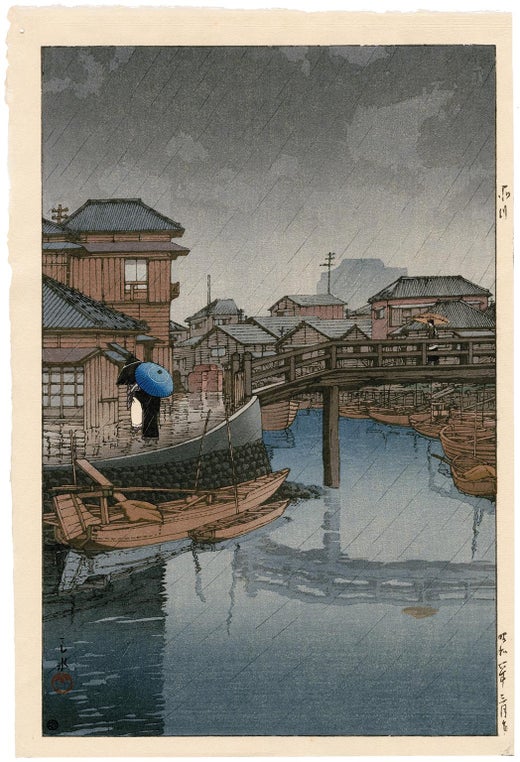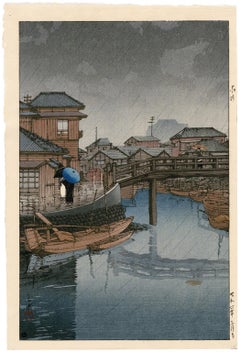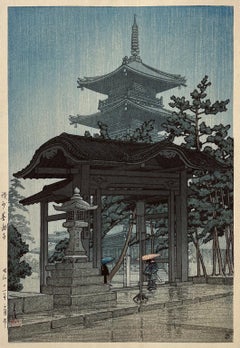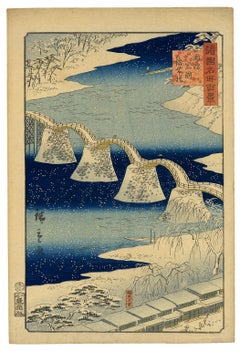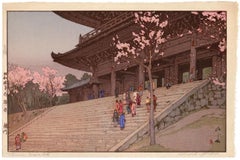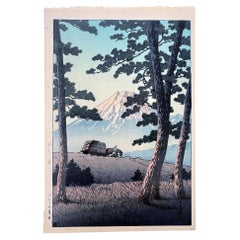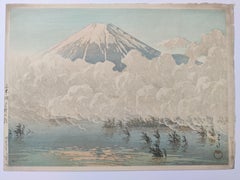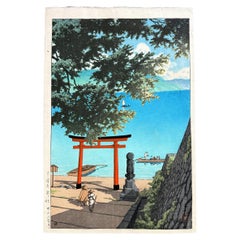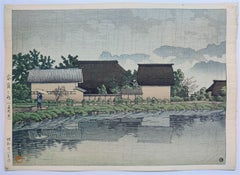Items Similar to 'The Beach at Kaiganji in Sanuki Province' — Lifetime Impression
Want more images or videos?
Request additional images or videos from the seller
1 of 3
Kawase Hasui'The Beach at Kaiganji in Sanuki Province' — Lifetime Impression1934
1934
$4,700
£3,594.68
€4,113.75
CA$6,689.39
A$7,242.66
CHF 3,850.59
MX$87,351.47
NOK 48,423.33
SEK 45,144.33
DKK 30,724.50
About the Item
Kawase Hasui, 'The Beach at Kaiganji in Sanuki Province (Sanuki Kaiganji no hama),' from the series Collected Views of Japan II, Kansai Edition (Nihon fûkei shû II Kansai hen), woodblock print, 1934. A very fine, atmospheric impression, with fresh colors; the full sheet, in excellent condition. Signed 'Hasui' with the artist’s seal 'Kawase', lower left. Published by Watanabe Shozaburo with the Watanabe ‘D’ seal indicating an early impression printed between 1931 - 1941. Stamped faintly 'Made in Japan' in the bottom center margin, verso.
Horizontal ôban; image size 9 3/8 x 14 1/4 inches (238 x 362 mm); sheet size approximately 10 5/16 x 15 1/2 inches ( 262 x 394 mm).
Collections: Art Institute of Chicago; Austrian Museum of Applied Arts (Vienna); Honolulu Museum of Art; Museum of Fine Arts, Boston; National Museum in Warsaw; University of Wisconsin-Madison.
ABOUT THE ARTIST
“I do not paint subjective impressions. My work is based on reality...I can not falsify...(but) I can simplify…I make mental impressions of the light and color at the time of sketching. While coloring the sketch, I am already imagining the effects in a woodblock print.” — Kawase Hasui
Hasui Kawase (1883–1957) is the most celebrated 20th-century Japanese print designer of the shin-hanga ('new prints') movement pioneered by the renowned publisher Watanabe Shozaburo. Hasui worked almost exclusively on landscape and townscape prints based on sketches he made in Tokyo and during his travels in Japan. His subjects are not only 'meishō' (famous places) prints which were typical of the earlier ukiyo-e masters such as Hiroshige and Hokusai, but also feature tranquil and picturesque scenes in obscure locations. Hasui considered himself a realist and employed his training in Western painting to create his lyrical renderings with naturalistic light, shade, and texture. Hasui was able to evoke the fleeting beauty of Japan during the interwar period as no other printmaker of his time could.
Hasui's work enjoyed huge popularity upon producing his first print in 1918. Watanabe recognized and developed the enormous potential of the American market, resulting in Hasui's prints achieving high prices at auctions in New York as early as the 1920s. After the Second World War, his prints became highly sought-after collectible works among the American occupying forces in Japan. Hasui designed more than 600 prints during the 40-year span of his artistic career, and in 1956, he was named a 'Living National Treasure' of Japan.
Hasui’s woodblock prints are included in many important museum collections of Japanese prints worldwide, including the Art Institute of Chicago; British Museum; Brooklyn Museum; Clark Art Institute; Cooper Hewitt, Smithsonian Design Museum; Freer Gallery of Art; Harvard Art Museums; Indianapolis Museum of Art; The Israel Museum, Jerusalem; Japan Ukiyo-e Museum, Matsumoto, Japan; Los Angeles County Museum of Art; Metropolitan Museum of Art; Minneapolis Institute of Art; MOA Museum of Art, Japan; Museum of Fine Arts, Boston; Nelson-Atkins Museum of Art; Portland Art Museum; Stanley Museum of Art; Toledo Museum of Art; Tokyo Museum Collection, Japan; University of Michigan Museum of Art, Walters Art Museum, Smart Museum of Art; and the Virginia Museum of Fine Arts.
- Creator:Kawase Hasui (1883-1957, Japanese)
- Creation Year:1934
- Dimensions:Height: 9.38 in (23.83 cm)Width: 14.25 in (36.2 cm)
- Medium:
- Movement & Style:
- Period:
- Condition:
- Gallery Location:Myrtle Beach, SC
- Reference Number:Seller: 981541stDibs: LU53238904302
Kawase Hasui
Hasui Kawase (Japanese, 1883 -1957) was an artist, one of modern Japan's most important and prolific printmakers. He was a prominent designer of the shin-hanga ("new prints") movement, whose artists depicted traditional subjects with a style influenced by Western art. Like many earlier ukiyo-e prints, Hasui's works were commonly landscapes, but displayed atmospheric effects and natural lighting. Hasui designed approximately 620 prints over a career that spanned nearly forty years. Towards the end of his life the government recognized him as a Living National Treasure for his contribution to Japanese culture. From youth Hasui dreamed of an art career. His maternal uncle was Kanagaki Robun (1829–94), a Japanese author and journalist, who produced the first manga magazine. Hasui went to the school of the painter Aoyagi Bokusen as a young man. He sketched from nature, copied the masters' woodblock prints, and studied brush painting with Araki Kanyu. His parents had him take on the family rope and thread wholesaling business, but its bankruptcy when he was 26 freed him to pursue art. He approached Kiyokata Kaburagi to teach him, but Kaburagi instead encouraged him to study Western-style painting, which he did with Okada Saburōsuke for two years. Two years later he again applied as a student to Kaburagi, who this time accepted him. Kiyokata bestowed the name Hasui upon him, which can be translated as "water gushing from a spring", and derives from his elementary school combined with an ideogram of his family name. Kawase studied ukiyo-e and Japanese style painting at the studio of Kiyokata Kaburagi. He mainly concentrated on making watercolors of actors, everyday life and landscapes, many of them published as illustrations in books and magazines in the last few years of the Meiji period and early Taishō period. Kawase worked almost exclusively on landscape and townscape prints based on sketches and watercolors he made in Tokyo and during travels around Japan. However, his prints are not merely meishō (famous places) prints that are typical of earlier ukiyo-e masters such as Hiroshige and Katsushika Hokusai (1760-1849). Kawase's prints feature locales that are tranquil and obscure in urbanizing Japan. Hasui Kawase's works are currently kept in several museums worldwide, including the British Museum, the Toledo Museum of Art, the Brooklyn Museum, the Indianapolis Museum of Art, the Museum of Fine Arts, Boston, the Metropolitan Museum of Art, the Portland Art Museum, the Los Angeles County Museum of Art, the University of Michigan Museum of Art, the Minneapolis Institute of Art, the Stanley Museum of Art, the Walters Art Museum, the Clark Art Institute, the Smart Museum of Art, the Nelson-Atkins Museum of Art, and the Virginia Museum of Fine Arts.
About the Seller
5.0
Recognized Seller
These prestigious sellers are industry leaders and represent the highest echelon for item quality and design.
Platinum Seller
Premium sellers with a 4.7+ rating and 24-hour response times
Established in 1995
1stDibs seller since 2016
333 sales on 1stDibs
Typical response time: 1 hour
Associations
International Fine Print Dealers Association
- ShippingRetrieving quote...Shipping from: Myrtle Beach, SC
- Return Policy
More From This Seller
View All'Rain at Shinagawa, Ryoshimachi' — Showa-era Woodblock Print
By Kawase Hasui
Located in Myrtle Beach, SC
Kawase Hasui, 'Rain at Shinagawa, Ryoshimachi' from the series 'Selection of Views of the Tokaido', woodblock print, 1931. A very fine, atmospheric impression, with fresh colors; the...
Category
1930s Showa Figurative Prints
Materials
Woodcut
Zentsuji Temple in the Rain — from the series Collected Views of Japan II
By Kawase Hasui
Located in Myrtle Beach, SC
Kawase Hasui, 'Zentsuji Temple in the Rain' from the seres 'Collected Views of Japan II', color woodblock print, 1937. Signed Hasui in black ink, with the artist’s red seal Kawase, ...
Category
1930s Showa Landscape Prints
Materials
Woodcut
Kintai Bridge at Iwakuni in Suo Province (Suo iwakuni kintai-bashi), 1859
By Hiroshige II
Located in Myrtle Beach, SC
Utagawa Hiroshige II (1829-1869), 'Kintai Bridge at Iwakuni in Suo Province' (Suo iwakuni kintai-bashi), from the series 'One Hundred Views of Famous Pla...
Category
1850s Edo Landscape Prints
Materials
Woodcut
'Chion-in Temple Gate' from 'Eight Scenes of Cherry Blossoms' — Jizuri Seal
By Hiroshi Yoshida
Located in Myrtle Beach, SC
Hiroshi Yoshida, 'Chion-in Temple Gate (Sunset)' from the series 'Eight Scenes of Cherry Blossoms (Sakura hachi dai: Sakura mon)', color woodblock print, 1935. Signed in brush 'Yoshida' and in pencil 'Hiroshi Yoshida'. A superb, early impression, with fresh colors; the full sheet with margins, on cream Japan paper; an area of slight toning in the top right sheet corner, not affecting the image, otherwise in excellent condition. Marked with a jizuri (self-printed) seal, upper left margin. Self-published by the artist.
Image size 9 5/8 x 14 3/4 inches (444 x 375 mm); sheet size 10 7/8 x 16 inches (276 x 406 mm). Archivally sleeved, unmatted.
Provenance: M. Nakazawa, Tokyo.
Literature: Japanese Landscapes of the 20th Century (Hotei Publishing calendar), 2001, May.
Collections: Honolulu Museum of Art, Museum of Fine Arts, Boston.
ABOUT THE IMAGE
Located in Kyoto, Chionin is the main temple of the Jodo sect of Japanese Buddhism, one of the most popular Buddhist sects in Japan, having millions of followers. The Sanmon Gate, Chionin's entrance gate, standing 24 meters tall and 50 meters wide, it is the largest wooden temple gate in Japan and dates back to the early 1600s. Behind the gate, a broad set of stairs leads to the main temple grounds.
ABOUT THE ARTIST
Painter and printmaker Yoshida Hiroshi (1876-1950) is regarded as one of the greatest artists of the Japanese 'shin hanga' (New Print) movement.
Yoshida was born as the second son of Ueda Tsukane in Kurume, Fukuoka Prefecture, a schoolteacher from an old samurai family. In 1891 he was adopted by his art teacher Yoshida Kasaburo in Fukuoka and took his surname. In 1893 he went to Kyoto to study painting, and the following year to Tokyo to join Koyama Shotaro's Fudosha private school; he also became a member of the Meiji Fine Arts Society. These institutions taught and advocated Western-style painting, greatly influencing Yoshida’s artistic development.
In 1899 Yoshida had his first American exhibition at Detroit Museum of Art (now Detroit Institute of Art), making the first of many visits to the US and Europe. In 1902 he helped reorganize the Meiji Fine Arts Society, renaming it the Taiheiyo-Gakai (Pacific Painting...
Category
1930s Showa Figurative Prints
Materials
Woodcut
'Interior of the Kannon Temple at Asakusa' — Tokyo Landmark, Early Edition
Located in Myrtle Beach, SC
NARAZAKI EISHO (1864-1936), 'Asakusa Kannon-do no naido' (Interior of the Kannon Temple at Asakusa), color woodblock print, 1932. Signed Eisho lower right, with the artist’s red seal beneath. A fine impression with fresh colors; the full sheet with slight overall age toning, a drying tack...
Category
1930s Interior Prints
Materials
Woodcut
'Tokaido' — Mt. Fuji Rising – Mid-Nineteenth Century Woodblock Print
By Utagawa Kunisada (Toyokuni III)
Located in Myrtle Beach, SC
Utagawa Kunisada (Tokoyuni III), 'Tokaido', color woodblock, 1863. Signed in the cartouche, lower right. A fine impression, with rich, fresh colors and pronounced woodgrain, the full...
Category
1860s Edo Figurative Prints
Materials
Woodcut
You May Also Like
Japanese Woodblock Print Evening at Tago Bay by Kawase Hasui
By Kawase Hasui 1
Located in Atlanta, GA
This print by Kawase Hasui (1883–1957), entitled Evening at Tago Bay (Tago no ura no yube), from the series Selected Views of the Tokaido Road (Tokaido fukei senshu) was created in S...
Category
Vintage 1940s Japanese Modern Prints
Materials
Paper
Kawase Hasui -- Morning in Hirano, Lake Yamanaka (山中湖平野の朝)
By Kawase Hasui
Located in BRUCE, ACT
Kawase Hasui
Morning in Hirano, Lake Yamanaka (山中湖平野の朝), 1936
Color woodblock print
Oban
Sheet: 31 × 42 cm
Image: 28.7 × 40 cm
First edition seal: 'D' seal
Published by Watanabe Shoz...
Category
1930s Prints and Multiples
Materials
Woodcut
Japanese Woodblock Print Chuzenji Temple at Utagahama Beach by Kawase Hasui
By Kawase Hasui 1
Located in Atlanta, GA
This woodblock print by Kawase Hasui (1883–1957), entitied Chuzenji Temple at Utagahama Beach, was created in Showa 6th year, 1931. The work depicts a red Torri gate leading to the v...
Category
20th Century Japanese Modern Prints
Materials
Paper
Kawase Hasui -- Rain at Yasuniwa (Nagano)
By Kawase Hasui
Located in BRUCE, ACT
Kawase Hasui
Rain at Yasuniwa (Nagano), 1946
woodcut in colours
Signed on the block, sealed, titled and dated in ink
Publisher: Shozaburo Watanabe, with his 6mm seal
The first state
...
Category
1940s Landscape Prints
Materials
Woodcut
$3,168 Sale Price
20% Off
Kawase Hasui -- Torii Gate at Miyajima in the Inland Sea of Japan
By Kawase Hasui
Located in BRUCE, ACT
Kawase Hasui
Torii Gate at Miyajima in the Inland Sea of Japan, 1930s
First Edition
Color woodcut on Japanese paper, with the artist's red seal Sui, with margin
Sheet size 9 1/4 x 14...
Category
1930s Prints and Multiples
Materials
Woodcut
Kawase Hasui -- Spring Rain at Gokoku Temple
By Kawase Hasui
Located in BRUCE, ACT
Kawase Hasui
Spring Rain at Gokoku-ji Temple, 1932
Woodblock Print
1st Publication: 1932
Sheet size: 39 × 26 cm
Date of this edition: 1932, 1st edition
Publisher: Doi Teiichi
Note...
Category
1930s Prints and Multiples
Materials
Woodcut
$8,640 Sale Price
20% Off
More Ways To Browse
20th Century Japanese Prints
Occupy Japan
Tattoo Nude
Toshio Iezumi
Used Cremation Urns
Vintage Beach Boys
Vintage Electric Chair
Vintage Taxi Cabs
Wild Bunch
Yves Klein Blue
1950 Fashion Illustrations
Antique Poster Food
Arman Resin
Baroque Painting Angel
Botanical Print Rose
Bronze Hippo
Charles Cary Rumsey
Club 57
